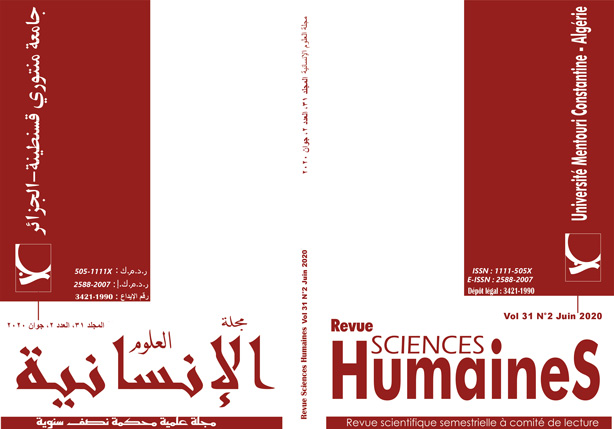Combining Written Discourse Analysis with the Teaching of Second Language Writing
الكلمات المفتاحية:
Writing، discourse analysis، written discourse analysis، cohesion، text patternsالملخص
The ever-increasing technological development along with the ever-decreasing distance between nations, cultures, and communities place writing at the top of the skills pyramid. Along with its social, communicative, and economic benefits, writing is an essential component of success within the educational enterprise and in language apprenticeship, more precisely. This paper looks at the practicality and possibility of applying written discourse analysis to the teaching of L2 writing for Second Year L.M.D students. A discourse-oriented paradigm of teaching writing uses written discourse analysis as a method of instruction which would raise the students’ awareness of the text and discourse patterns and develop their abilities of topic introductions, smooth shifts, persuasion devices, and their lexico-syntactic means of establishing cohesion.
التنزيلات
المراجع
Bereiter, C., & Scardamalia, M. (1987). The psychology of written composition.
Hillsdale, NJ, US: Lawrence Erlbaum Associates, Inc.
Brown, G. & Yule, G. (1983). Discourse analysis. Cambridge: Cambridge University Press.
Cameron, D. (ed.). (2001). Working with spoken discourse. London: Sage.
Collins, A., & Gentner D. (1980). A Framework for a cognitive theory of writing. In L.W Gregg and E.R. Steinberg (Eds.), Cognitive process in writing (pp. 51-52). Hillsdale, N.J: Erlbaum.
Cook, G. (1989). Discourse. Oxford: Oxford University Press.
Coulthard, M. (1994). On analyzing and evaluating written text. In M. Coulthard. (Ed.), Advances in written text analysis (pp. 1-11). London: Routledge.
Crystal, D. (1992). Introducing linguistics. Harlow: Penguin.
Ellis, R. (2003). A framework for investigating oral and written corrective feedback. Studies in Second Language Acquisition, 32(2), 335-349.
Grabe, W. (1984). Written discourse analysis. In R. B. Kaplan (Ed.), Annual review of applied linguistics (Vol. 5, pp. 101–123). New York: Cambridge University.
Graham, C.R. (2006). The handbook of blended learning environments: Global perspectives, local designs. San Francisco:
Halliday, M. A. K. (1994). An introduction to functional grammar. (2nded.). London: Rnold. Halliday, M. A. K., & Hasan, R. (1976). Cohesion in English. London: Longman.
Harley, T. A. (2008). The psychology of language: From data to theory. (4thed) Hove: Psychology Press.
Harris, D. P. (1969). Testing English as a second language. New York: Mc Graw Hill Book Company.
Hoey, M. P. (1983). On the surface of discourse. London: Allen & Unwin.
Hatch, E. 1992 Discourse and Language Education. Cambridge: Cambridge University Press.
Martin, J. R. & Rose, D., Cameron (2007). Working with discourse. meaning beyond the clause. (2nd ed.). London: Continuum.
McCarthy, M. (1991). Discourse analysis for language teachers. Cambridge: Cambridge University Press.
Nunan, D. (1991) Language teaching methodology. Hemel Hempstead: Prentice Hall.
Nunan, D. (1993). Introducing discourse analysis. London: Penguin
Renkema, J. (2004). Introduction to discourse studies. Netherlands: John Benjamins.
Schiffrin, D. (1994). Approaches to discourse. Oxford: Blackwell.
Smith, F. (2004). Understanding reading. (6th ed.). Mahwah, NJ: Lawrence Erlbaum Associates.
Swales, J. M. (1990). Genre Analysis: English in Academic and Research Settings. Cambridge [England] ; New York: Cambridge University Press
Thomas, B.J. (1995) Intermediate Vocabulary. London: Longman. Widdowson, H. G. (2007). Discourse analysis. Oxford: Oxford University Press.
Winter, E. (1994). Clause relations as information structure: Two basic text structures in English. In: M. Coulthard (Ed.), Advances in written text analysis (pp. 46- 68). London, New York: Routledge.
Witte, S. & Faigley, L., (1981). Coherence, cohesion, and writing quality. College Composition and Communication, 32, 189–204.
التنزيلات
منشور
كيفية الاقتباس
إصدار
القسم
الرخصة

هذا العمل مرخص بموجب Creative Commons Attribution-NonCommercial-ShareAlike 4.0 International License.
















